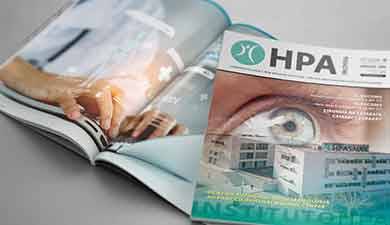Enfº Tito Manuel Félix
Specialist Nurse
in Obstetrics and Maternal Health

The fourth quarter
Or the new postpartum care paradigm
HPA Magazine 16
The Pregnancy Control Plan is usually divided into three trimesters and each trimester into weeks.
Each trimester of pregnancy has a different evolution requiring different attention and different care.

1st TRIMESTER
The first trimester is the surprise of a life project that materializes with a simple pharmacy test or with the first ultrasound, where the gestational age is stipulated and the gestational sac and embryo are visualized.
It is the period when pregnancy is confirmed, uncertainties on its normal evolution is screened, including chromosomopathies of the foetal DNA test, of possible haemorrhages, of the most common complications such as the initial discomforts of pregnancy. The first analyses take place and the entire surveillance process formally begins with the obstetrician of choice.
2nd TRIMESTER
This is the trimester when many couples reveal the news of their pregnancy to the family. It is described as being the trimester of tranquillity due to the certainty that pregnancy is evolving. Future plans become more solid and promising. It is the trimester when perception of the foetus begins as it becomes real and present. At this stage morphological ultrasound and screening for foetal malformations and foetal echocardiography are performed. Physical changes are more noticeable.
3rd TRIMESTER
In this trimester, maternal-foetal surveillance is intensified and focus is placed not only on the mother and foetus, but also on childbirth. It is during this period that preparation sessions for parenthood/childbirth is recommended. From 37th week, interval between appointments is reduced to weekly, CTG's are begun to assess foetal well-being, previously discusses plans for delivery are discussed and all the couple's expectations are explained and considered, to make sure that what they idealized for that moment takes place: location, type of delivery, surrounding environment, practices such as cutting the cord (when and by whom), pharmacological/non-pharmacological pain relief measures, position in the expulsive period, immediate skin-to-skin contact, among others. The alarm signals are reinforced at this stage, the importance of foetal movement perception is underlined as the main guarantee of foetal well-being, and also the first signs of childbirth when it is time to go to the Maternity. It is in this quarter that pregnancy reaches term, except in situations where the birth is previously scheduled, it can occur at any time.
Now the 3rd trimester, 40 weeks, 280 days later, it is time for the long-awaited 1st meeting. All the investment made during pregnancy surveillance has resulted in a positive outcome and we have a healthy mother and new-born infant, regardless of the type of delivery that took place. However, new challenges and tasks arise. Although the tasks of pregnancy surveillance have come to an end, the process continues with the surveillance of the mother and infant.
Homeostasis during this period results from the way in which this new postpartum phase was also prepared. How was breastfeeding planned with all its processes and constraints? Is there a breastfeeding plan? What options are there to ensure division of tasks and rest periods? Is there a support structure? Who is the best person to support this stage? Husband? Mom? How to manage the advice that comes from all sides and interferes with what the couple thinks and defends? Whom to listen to? To professionals or family? How to synthesize so much information? How to deal with and understand the crying of the new-born infant? How to overcome feelings of doubt, impotence and inability to care for the new member of the family? How can we sometimes reconcile the moment of extreme happiness during the birth of a child with an uncontrollable sadness, anguish and crying that result in an ambivalence of feelings and a dominant emotional lability? And the physical difficulty resulting from the pain and impact of pregnancy and childbirth on your own body? Where is the ideal world, perfect, painted in soft colours, calm and tranquil that we are promised? The puerperium colours are sometimes sombre and the difficulties, doubts and insecurities are sometimes all but serene and comforting.
All these questions mentioned here, if not given very direct answers and solutions, can result in a problematic situation not only on the mother's physical health, but especially on her mental health, with serious implications for her relationship with her close family circle but above all with herself, when faced with her new role of being a mother. Ultimately, this state of emotional and functional ambivalence the “postpartum blues”, can lead to a more serious picture of postpartum depression, with serious risks for the safety of the mother, baby and family.
In this context, it is not in vain that one of the main recommendations issued by the American College of Obstetricians & Gynaecologists (ACOG) is precisely the optimization of surveillance of the mother’s health and well-being in the postpartum period (1).
The importance of care in the immediate, early and late puerperium are placed on the same level as the importance of monitoring during pregnancy.
The need to draw up a postpartum plan during the pregnancy surveillance consultations is particularly underlined, together with the birth and breastfeeding plans already implemented in our Maternity.
Therefore, planning for the 4th Quarter is something that must be done and thought about during pregnancy and adjusted during the postpartum hospitalization.
This period includes the first 12 weeks after delivery, where consultations are recommended with the necessary frequency depending on the needs defined during the hospital stay. In linear situations (low-risk pregnancy & postpartum period) the new-born infant must be referred for a consultation during the first week of life and the mother in the 6th week after delivery.
To ensure that there is no risk of the puerperal woman entering a pathological postpartum period and to ensure that the impact of complications during the 4th Quarter are minimized, the ACOG recommends that, in preparing for hospital discharge, the health team conducts a survey of the couple's needs so that their return home is calm and sustained, and it is particularly important to alert for the following needs: rest, adequate nutrition and support network, which can be both family and institutional.








